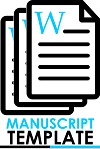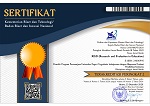Rasch model analysis of essay questions to measure literacy and numeracy skills in plant and animal bioprocess topics based on AKM
DOI:
https://doi.org/10.21831/reid.v11i1.85614Keywords:
Assessment Instrument, reading literacy test, Numeracy literacy, biology education, Rasch ModelAbstract
Literacy skills in reading and numeracy in Indonesia are classified as low, so the government has made new policies, one of which is the application of questions based on the Minimum Competency Assessment (AKM) in the National Assessment. Observation results from several high schools in Pekanbaru, Riau, have not shown the application of AKM questions to biology learning. This research aimed to produce AKM-based reading and numeracy literacy instruments on high school plant and animal bioprocess materials used in Research and Development (R&D) design, where the subjects were grade XII students at three high schools in Pekanbaru city. Data collection instruments were the test instruments that had been developed. Data were analyzed using Rasch modelling assisted by Winstep software, including Wright map analysis, person capability analysis, item capability analysis, scalogram analysis, and question item analysis. The results show that most students have a logic score below 0.0, meaning that reading and numeracy literacy skills and understanding concepts are still low. Four out of 63 students have inappropriate answer patterns, indicating that students did not work on the questions seriously. Then, the analysis results show 14 fit questions; having a Cronbach alpha value of 0.84 with a very high interpretation, a person reability value of 0.77 with sufficient interpretation, and an item reability value of 0.92 in the very high category; the difficulty level of the question items is in line with the rules of the test instrument development, since there is a spread of difficulty of the question items starting from very difficult, hard, medium, easy, and very easy. Thus, it is concluded that the instrument test can be used to measure reading literacy and numeracy skills based on AKM on plant and animal bioprocess materials.
References
Aisah, H., Zaqiah, Q. Y., & Supiana, A. (2021). Implementasi kebijakan asesmen kemampuan minimum (AKM): Analisis implementasi kebijakan AKM). Al-Affan Journal of Islamic Education, 1(2), 128–135. https://doi.org/10.69775/jpia.v1i2.25
Andrich, D., & Marais, I. (2019). A course in Rasch measurement theory. Springer Singapore.
Bagiyono. (2017). Analisis tingkat kesukaran dan daya pembeda butir soal ujian pelatihan radiografi tingkat 1. Widyanuklida, 16(1), 1–12. https://lib.ui.ac.id/detail?id=20470998&lokasi=lokal
Boone, W. J. (2016). Rasch analysis for instrument development: Why, when, and how? CBE Life Sciences Education, 15(4). https://doi.org/10.1187/cbe.16-04-0148
Cahyana, A. (2020). Prospek AKM dan survei karakter: Memperkuat basis praliterasi dan pranumerasi usia dini. Banpaudpnf Kemendikbud, 1(1), 1–4.
Chan, S. W., Ismail, Z., & Sumintono, B. (2014). A Rasch model analysis on secondary students’ statistical reasoning ability in descriptive statistics. Procedia - Social and Behavioral Sciences, 129, 133–139. https://doi.org/10.1016/j.sbspro.2014.03.658
Dwinata, A. (2019). Analisis kemampuan pemecahan masalah menggunakan pemodelan RASCH pada materi permutasi dan kombinasi. In Prosiding Seminar Nasional Matematika, 2, 124–131. https://journal.unnes.ac.id/sju/prisma/article/view/28899
Fazilah, N., Azhari, T., & Ardesi, R. P. (2023). Dampak penggunaan Wattpad terhadap kemampuan literasi membaca siswa SMA negeri. Jurnal Ilmiah Pendidikan Bahasa dan Sastra Indonesia, 4(2), 255-262. https://doi.org/10.29103/jk.v4i2.13448
Finbråten, H. S., Wilde-Larsson, B., Nordström, G., Pettersen, K. S., Trollvik, A., & Guttersrud, Ø. (2018). Establishing the HLS-Q12 short version of the European Health Literacy Survey Questionnaire: Latent trait analyses applying Rasch modelling and confirmatory factor analysis. BMC Health Services Research, 18(1), 1-17. https://doi.org/10.1186/s12913-018-3275-7
Fiskha, S. D., & Heswari, S. (2022). Analisis kemampuan numerasi siswa kelas VIII SMP se-Kota Sungai Penuh dalam menyelesaikan soal AKM. Jurnal Muara Pendidikan, 7(2), 232-237. https://doi.org/10.52060/mp.v7i2.919
Hasanah, H., & Aini, F. Q. (2025). Pengembangan instrumen tes keterampilan proses sains pada topik kesetimbangan kimia: Analisis dengan model Rasch. JagoMIPA: Jurnal Pendidikan Matematika dan IPA, 5(1), 68–82. https://doi.org/10.53299/jagomipa.v5i1.1043
Hikmah, F. N., Sukarelawan, Moh. I., Nurjannah, T., & Djumati, J. (2021). Elaboration of high school student’s metacognition awareness on heat and temperature material: Wright map in Rasch model. Indonesian Journal of Science and Mathematics Education, 4(2), 172–182. https://doi.org/10.24042/ijsme.v4i2.9488
Jacob, E, R., Duffield, C., & Jacob, A, M. (2019). Validation of data using Rasch analysis in a tool measuring changes in critical thinking in nursing students. Nurse Education Today, 76, 196-199. https://doi:10.1016/j.nedt.2019.02.012
Jimam, N. S., Ismail, N. E., Dangiwa, D. A., Dapar, M. L. P., Sariem, C. N., Paul, L. A., Mohammed, S. G., & Dayom, D. W. (2021). Use of Rasch Wright map to understand the quality of Healthcare Workers’ Knowledge, Attitudes, and Practices for Uncomplicated Malaria (HKAPIUM). Journal of Pharmacy & Bioresources, 18(3), 237–244. https://doi.org/10.4314/jpb.v18i3.8
Kurli, H., Haliqah, N., & Anekawati, A. (2021). Analisis kemampuan kognitif siswa pada mata pelajaran IPA SMP menggunakan Rasch model. Journal of Medical Entrepreneurs, 1(2), 74-79. https://doi.org/10.55748/bjel.v3i2.133
Leeming, P., & Wong, A. (2016). Using dictation to measure language proficiency: A Rasch analysis. Papers in Language Testing and Assessment, 5(2), 1-25. https://doi.org/10.58379/mbsw8958
Lestari, A. S., & Samsudin, A. (2020). Using Rasch model analysis to analyze students’ scientific literacy on heat and temperature. In Proceedings of the 7th Mathematics, Science, and Computer Science Education International Seminar (MSCEIS) 2019, 1-8. https://doi.org/10.4108/eai.12-10-2019.2296483
Mardiani, N., & Wahyuni, S. (2022). Implementasi Gerakan Literasi Sekolah (GLS) sebagai upaya meningkatkan keterampilan membaca dan menulis di SMA Negeri 3 Batusangkar. JIPIS: Jurnal Ilmu Perpustakaan dan Informasi Islam, 1(1), 8-14. https://doi.org//10.31958/jipis.v1i1.5946
Mawaddah, Y. (2020). Penggunaan model discovery learning dengan metode praktikum terhadap peningkatan partisipasi dan hasil belajar siswa pada materi sel di MAS Nurul Islam Blang Rakal. Undergraduate Thesis, UIN Ar-Raniry Banda Aceh, Aceh. https://repository.ar-raniry.ac.id/id/eprint/11217/
Meriana, T., Murniarti, E., & Dasar Kanaan, S. (2021). Analisis pelatihan asesmen kompetensi minimum. Journal of Educational Dynamics, 14(2), 110-116. https://doi.org/10.51212/jdp.v14i2.7
Millah, E. S., Budipramana, L. S., & Isnawati. (2012). Pengembangan buku ajar materi bioteknologi di kelas XII SMA IPIEMS Surabaya berorientasi Sains, Teknologi, Lingkungan, dan Masyarakat (SETS). Berkala Ilmiah Pendidikan Biologi (BioEdu), 1(1), 19-24. https://ejournal.unesa.ac.id/index.php/bioedu/article/view/344
Ministry of Education and Culture. (2020). AKM dan implikasinya pada pembelajaran. Centre for Assessment and Learning of the Research and Development Agency and Books of the Ministry of Education and Culture.
Ngadi, N. (2023). Analisis model Rasch untuk mengukur kompetensi pengetahuan siswa SMKN 1 Kalianget pada mata pelajaran perawatan sistem kelistrikan sepeda motor. Jurnal Pendidikan Vokasi Otomotif, 6(1), 1-19. https://doi.org/10.21831/jpvo.v6i1.63479
Novita, N., Mellyzar, M., & Herizal, H. (2021). Asesmen Nasional (AN): Pengetahuan dan persepsi calon guru. JISIP (Jurnal Ilmu Sosial dan Pendidikan), 5(1), 172-179. https://doi.org/10.36312/jisip.v5i1.1568
Nurjanah, W. L., Sari, I. M., & Saepuzaman, D. (2024). Analisis pemahaman konsep peserta didik pada topik perambatan kalor menggunakan Rasch model. Didaktika: Jurnal Kependidikan, 13(2), 1361-1374. https://jurnaldidaktika.org/contents/article/view/442
OECD. (2019). PISA 2018 assessment and analytical framework. OECD. https://doi.org/10.1787/b25efab8-en
Qisthi, C. U., Abidin, Z., & Sulistyono, S. (2023). Pengembangan instrumen literasi numerasi biologi pada pembelajaran IPA dalam materi sistem pernapasan pada manusia. Jurnal Ilmiah Wahana Pendidikan, 9(22), 191-202. https://doi.org/10.5281/zenodo.10096812
Pereira, J., Tang, J., Soares, B., Prihandini, R, M., & Wijaya, T, T. (2022). Exploring the accuracy of mathematics students on the final semester assessment based on Racsh model analysis in Timor-Leste. In Proceedings of the 2nd International Conference on Emerging Technologies and Intelligent Systems, 416-425. https://doi.org/10.1007/978-3-031-20429-6_38
Purniasari, L., Masykuri, M., Sri, D., & Ariani, R. D. (2021). Analisis butir soal ujian sekolah mata pelajaran kimia SMA N 1 Kutowinangun tahun pelajaran 2019/2020 menggunakan model iteman dan Rasch. Journal of Chemistry Education, 10(2), 205–214. https://doi.org/10.20961/jpkim.v10i2.48244
Ridzuan, M. F., Lim, H. L., Ahmad Fozee, F. A., & Mohd Nasser, S. N. A. (2020). Rasch analysis model: Reliability and validity of superitem test instrument. International Journal of Academic Research in Progressive Education and Development, 9(4), 1-11. https://doi.org/10.6007/ijarped/v9-i4/8166
Rifqiawati, I., Ratnasari, D., Wahyuni, I., & Juwita, I. S. (2020). Penerapan biomagazine sebagai bahan ajar biologi terhadap literasi membaca dan motivasi belajar siswa kelas X di SMA Negeri 7 Pandeglang. Biodidaktika: Jurnal Biologi dan Pembelajarannya, 15(1), 87-93. http://dx.doi.org/10.30870/biodidaktika.v15i1.8205
Rintarti, E. W., & Dwi, M. K. (2021). Pengaruh model problem based learning berbantuan software Cabri 3D V2 terhadap kemampuan literasi numerasi siswa. Jurnal Cendekia: Jurnal Pendidikan Matematika, 5(2), 1687-1699. https://doi.org/10.31004/cendekia.v5i2.690
Rigianti, H. A., & Utomo, A. C. (2022). Asesmen kompetensi minimum ranah literasi membaca dan implikasinya di sekolah dasar. Jurnal Education and Development, 11(1), 133–137. https://doi.org/10.37081/ed.v11i1.4254
Rijal, M. M., & Imron, A. (2020). Strategi kepala sekolah dalam meningkatkan literasi membaca siswa di SMA Negeri 1 Kota Kediri. Indonesian Journal of Islamic Education Studies, 3(1), 16-30. https://doi.org/10.33367/ijies.v3i1.1138
Rizki, I. M., Suhendar, S., & Nuranti, G. (2022). Profil kemampuan literasi numerasi peserta didik SMA pada pembelajaran biologi kelas XII pada materi evolusi. BIODIK: Jurnal Ilmiah Pendidikan Biologi, 8(3), 36-42. https://online-journal.unja.ac.id/biodik/article/view/18978
Rokhim, D. A., Rahayu, B. N., Alfiah, L. N., Peni, R., Wahyudi, B., Wahyudi, A., Sutomo, S., & Widarti, H. R. (2021). Analisis kesiapan peserta didik dan guru pada asesmen nasional (Asesmen kompetensi minimum, survey karakter, dan survey lingkungan belajar). Jurnal Administrasi dan Manajemen Pendidikan, 4(1), 61-71. https://doi.org/10.17977/um027v4i12021p61
Rosidah, D. M., & Sabtiawan, W. B. (2024). Profil keterampilan berpikir tingkat tinggi siswa SMP pada materi ekosistem. JIIC: Jurnal Intelek Insan Cendikia, 1(7), 2893-2900. https://jicnusantara.com/index.php/jiic/article/view/997
Rosiqoh, R., & Suhendi, E. (2021). Using Rasch model analysis to analyse students’ mastery of concept on Newton law. Journal of Physics: Conference Series, 1731(1), 1-6. https://doi.org/10.1088/1742-6596/1731/1/012077
Rusiyah, R., Eraku, S., & Supadmi, S. (2020). Analysis of geography subject final semester exam questions using Rasch modeling. Swarnabhumi Journal, 5(1), 11-18. https://doi:10.31851/swarnabhumi.v5i1.4136
Sari, E. D. K., & Mahmudi, I. (2024). Buku analisis pemodelan Rasch pada asesmen pendidikan. PT. Persada Kerta Utama Pen.
Sartika, S., & Mukhlis, M. (2023). Higher order thinking skills pada soal AKM literasi membaca di SMK Pertanian Pekanbaru. GERAM (Gerakan Aktif Menulis), 11(1), 39–47. https://doi.org/10.25299/geram.2023.vol11(1).12151
Sensus, M., Arifin, K., & Munir, A. (2022). Validitas soal pada asesmen kompetensi minimum materi ekologi SMA kelas X. Wahana Bio: Jurnal Biologi dan Pembelajarannya, 14(1), 1-10. https://ppjp.ulm.ac.id/journal/index.php/wb/article/view/14013
Sudihartinih, E., & Wahyudin, W. (2019). Analysis of students’ self efficacy reviewed by geometric thinking levels and gender using Rasch model. Journal of Engineering Science and Technology, 14(1), 509-519. https://jestec.taylors.edu.my/Vol%2014%20issue%201%20 February%202019/14_1_35.pdf
Sumintono, B. (2018). Rasch model measurements as tools in assessment for learning. Advances in Social Science, Education and Humanities Research, 173, 38-41. https://doi:10.2991/icei-17.2018.11
Sumintono, B., & Widhiarso, W. (2015). Aplikasi pemodelan Rasch pada asesmen pendidikan. Trim Komunikata.
Susilowati, N. I., Liliawati, W., & Rusdiana, D. (2023). Science process skills test instruments in the new Indonesian curriculum (Merdeka): Physics subject in renewable energy topic. Indonesian Journal of Teaching in Science, 3(2), 121–132. https://doi.org/10.17509/ijotis.v3i2.60112
Syadiah, A. N., & Hamdu, G. (2020). Analisis Rasch untuk soal tes berpikir kritis pada pembelajaran STEM di sekolah dasar. Premiere Educandum: Jurnal Pendidikan Dasar dan Pembelajaran, 10(2), 138-148. https://doi.org/10.25273/pe.v10i2.6524
Tesio, L., Caronni, A., Kumbhare, D., & Scarano, S. (2024). Interpreting results from Rasch analysis 1. The “most likely” measures coming from the model. Disability and Rehabilitation, 46(3), 591–603. https://doi.org/10.1080/09638288.2023.2169771
Tyas, E. H., Hamdu, G., & Pranata, O. H. (2020). Analisis soal pilihan ganda dengan menggunakan pemodelan RASCH untuk mengukur kemampuan siswa dalam mengurutkan bilangan pecahan di sekolah dasar. Scientific Journal of Elementary School Teacher Education, 7(2), 1-12. https://doi.org/10.17509/pedadidaktika.v7i2.24773
Uba, A. R., & Khairani, A. Z. (2024). Assessing item reliability, differential item functioning, and Wright map analysis of the GSP122 test at a public university in Nigeria. Journal of Education for Sustainable Innovation, 2(2), 107–120. https://doi.org/10.56916/jesi.v2i2.934
Widhiarso, B. S. (2013). Aplikasi model RASCH untuk penelitian ilmu-ilmu sosial. Trim Komunikata Publishing House.
Yulianto, A., & Widodo, A. (2020). Disclosure of difficulty distribution of HOTS-based test questions through Rasch modeling. Indonesian Journal of Primary Education, 4(2), 197–203. https://doi.org/10.17509/ijpe.v4i2.29318
Downloads
Published
How to Cite
Issue
Section
Citation Check
License
Copyright (c) 2025 REID (Research and Evaluation in Education)

This work is licensed under a Creative Commons Attribution-ShareAlike 4.0 International License.
The authors submitting a manuscript to this journal agree that, if accepted for publication, copyright publishing of the submission shall be assigned to REID (Research and Evaluation in Education). However, even though the journal asks for a copyright transfer, the authors retain (or are granted back) significant scholarly rights.
The copyright transfer agreement form can be downloaded here: [REID Copyright Transfer Agreement Form]
The copyright form should be signed originally and sent to the Editorial Office through email to reid.ppsuny@uny.ac.id

REID (Research and Evaluation in Education) by http://journal.uny.ac.id/index.php/reid is licensed under a Creative Commons Attribution-ShareAlike 4.0 International License.







.png)





